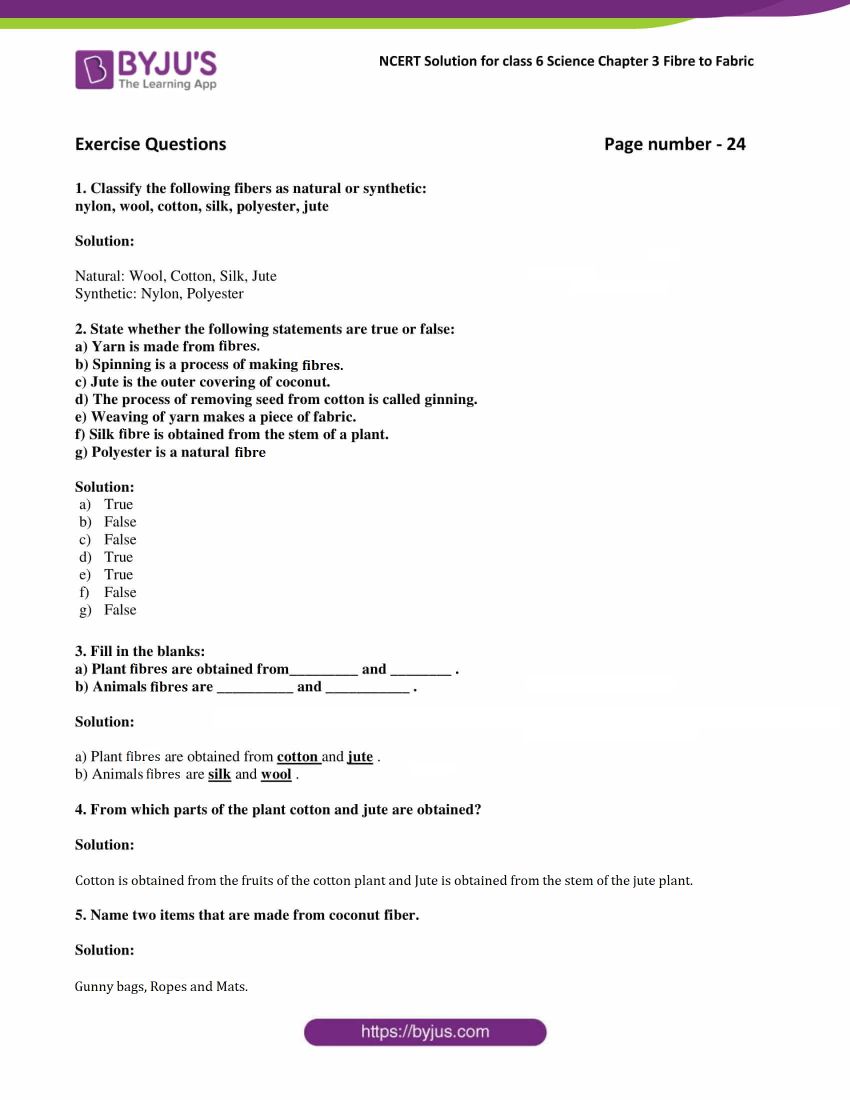NCERT Solutions for Class 6 Science Chapter 3 Fibre To Fabric
NCERT Solutions for Class 6 Science Chapter 3 Fibre to Fabric is given here in a simple and easy to understand way. After learning these NCERT Solutions, students will be able to clear all their doubts on the concepts involved in CBSE Class 6 Science Chapter 3. Fibre to Fabric teaches you about the production of fabrics from yarns, synthetic fibres, natural fibres, the process of spinning, weaving and knitting.NCERT Solutions Class 6 Chapter 3
Download PDF of NCERT Solutions for Class 6 Science Chapter 3 Fibre to Fabric


Answers to true or false, fill in the blanks and descriptive answer questions will provide you with a greater understanding of the topics involved in the Chapter. To score good marks in CBSE Class 6 examination students are advised to study this study material thoroughly. NCERT Solutions for Class 6 Science provided here will assist you in getting the practice of solving a variety of questions before writing the main examination. This solution, which is prepared by subject experts will create strong basics, will further help in the understanding of advanced topics in future.
Access Answers of NCERT Solutions for Class 6 Science Chapter 3 Fibre to Fabric
Exercise Questions
1. Classify the following fibers as natural or synthetic:
nylon, wool, cotton, silk, polyester, jute
Solution:
Natural: Wool, Cotton, Silk, Jute
Synthetic: Nylon, Polyester
2. State whether the following statements are true or false:
a) Yarn is made from fibres.
b) Spinning is a process of making fibres.
c) Jute is the outer covering of coconut.
d) The process of removing seed from cotton is called ginning.
e) The weaving of yarn makes a piece of fabric.
f) The silk fibre is obtained from the stem of a plant.
g) Polyester is a natural fibre.
Solution:
a) True
b) False
c) False
d) True
e) True
f) False
g) False
3. Fill in the blanks:
a) Plant fibres are obtained from_________ and ________ .
b) Animals fibres are __________ and ___________ .
Solution:
a) Plant fibres are obtained from cotton and jute.
b) Animals fibres are silk and wool.
4. From which parts of the plant cotton and jute are obtained?
Solution:
Cotton is obtained from the fruits of the cotton plant and Jute is obtained from the stem of the jute plant.
5. Name two items that are made from coconut fiber.
Solution:
Gunny bags, Ropes and Mats.
6. Explain the process of making yarn from fiber.
Solution:
Yarn can be made from fibre by the process called Spinning. From the mass of cotton, fibres are drawn and twisted which brings together the fibres to form a yarn. Takli and Charkha are the devices used for spinning.
Important topics covered in NCERT Solutions for Class 6 Science Chapter 3 Fibre to Fabric
- Variety in Fabrics
- Fibre
- Some Plant Fibres
- Spinning Cotton Yarn
- Yarn to Fabric
- History of Clothing Material
Frequently Asked Questions on NCERT Solutions for Class 6 Science Chapter 3
Explain the process of making yarn from fibre from the Chapter 3 of NCERT Solutions for Class 6 Science.
Yarn can be made from fibre by the process called Spinning. From the mass of cotton, fibres are drawn and twisted which brings together the fibres to form a yarn
What concepts can I learn from the Chapter 3 of NCERT Solutions for Class 6 Science?
From the Chapter 3 of NCERT Solutions for Class 6 Science, you can learn about concepts like –
Variety in Fabrics
Fibre
Some Plant Fibres
Spinning Cotton Yarn
Yarn to Fabric
History of Clothing Material
How many questions are present in the Chapter 3 of NCERT Solutions for Class 6 Science?
There are about 6 questions present in the Chapter 3 of NCERT Solutions for Class 6 Science. Students who are not able to answer the textbook questions are advised to refer to the solutions prepared by the faculty at BYJU’S. The solutions are created as per the latest CBSE syllabus and guidelines to help students ace the exam without fear. Using the solutions on a daily basis will enable students to answer complex questions that would appear in the exam. The expert faculty design the solutions with the aim of helping students to score well in the annual exams.
